Photographs: Scott Audette/reuters
Space shuttle Atlantis touched down safely in its final landing at the Kennedy Space Centre in Houston on Thursday, bringing the curtain down on the National Aeronautics and Space Administration's 30-year space shuttle programme -- considered one of the most eventful eras in the US history of manned spaceflight.
Atlantis landed just before sunrise after 200 orbits around the Earth and a journey of 85,05,140 kilometres on STS-135, at 6 am local time, completing its 13-day mission to the International Space Station.
Around 2,000 people gathered to watch the historic landing, which came as a long-awaited -- and much-dreaded -- milestone marking the end of an eventful era for the US manned spaceflight.
It was the 25th night landing, the 78th landing at Kennedy and the133rd landing in shuttle history.
We take a look at some of Atlantis' exemplary missions over the years
...
Atlantis: The maiden voyage
Image: Mission STS-51J was the first flight of space shuttle Atlantis, launching October 3, 1985 to deliver a communications satellite for the Department of Defense.Photographs: NASA
Atlantis was delivered to Kennedy Space Centre in April 1985. It lifted off on its maiden voyage on October 3, 1985, on mission 51-J, the second dedicated Department of Defence flight.
Later missions included the launch of the Galileo interplanetary probe to Jupiter on STS-34 in October 1989, and STS-37, with the Gamma Ray Observatory as its primary payload, in April 1991.
Atlantis was named after a two-masted sailing ship that was operated for the Woods Hole Oceanographic Institute in Massachusetts, from 1930 to 1966.
...Launch of Galileo spacecraft
Image: The Space Shuttle Atlantis - carrying the Galileo spacecraft - soars above Florida on Oct. 18, 1989. The scene was recorded with a 70mm camera by astronaut Daniel Brandenstein.Photographs: NASA
Galileo was launched October 18, 1989, from Kennedy Space Centre, Florida, carried into the Earth orbit in the cargo bay of space shuttle Atlantis.
A two-stage solid-fuel motor called an inertial upper stage then propelled Galileo onto its interplanetary flight path. Although earlier plans called for Galileo to use a more powerful upper stage so that it could fly directly to Jupiter, the final flight took the spacecraft by other planets first so that it could gain energy from the gravity of each.
Galileo flew past Venus on February 10, 1990, and then twice past Earth -- once on December 8, 1990 -- and again on December 8, 1992.
...Launch of Magellan spacecraft
Image: The Magellan spacecraft is deployed from the cargo bay of the Space Shuttle Atlantis (STS 30) in 1989. Magellan was the first planetary spacecraft launched from the space shuttle.Photographs: NASA
Magellan was the first planetary spacecraft to be launched by a space shuttle when it was carried aloft by the shuttle Atlantis from Kennedy Space Centre in Florida on May 4, 1989.
Atlantis took Magellan into low Earth orbit, where it was released from the shuttle's cargo bay. Magellan was the fourth successful NASA-funded mission to Venus and ended an 11-year US interplanetary exploration hiatus.
Magellan's mission ended with a dramatic plunge to the planet's surface, the first time an operating planetary spacecraft has ever been intentionally crashed.
Contact was lost with the spacecraft on October 12, 1994.
...
1995: Atlantis meets Mir
Image: The Shuttle-Mir program helped pave the way for the International Space Station now in orbit.Photographs: NASA
NASA and the Russian space agency kicked off a new era in international space cooperation in June of 1995, when the Space Shuttle Atlantis docked with the Russian space station Mir for the first time.
Atlantis' mission, STS-71, launched on June 27 and marked the 100th US human space launch. Together, Atlantis and Mir became the largest combined spacecraft ever in orbit, totaling almost a half a million pounds.
For the docking, Shuttle Commander Hoot Gibson positioned Atlantis directly below Mir, so that the Earth's gravity naturally braked the orbiter's approach "up" to Mir. The final approach rate of about an inch per minute ended 216 nautical miles above Russia's Lake Baykal region, with a nearly perfect docking, off by less than one inch and one half a degree.
The Shuttle-Mir programme included 11 Space Shuttle flights and 7 astronaut residencies on Mir, and helped pave the way for the International Space Station now in orbit.
...
2001: Atlantis delivers Destiny
Image: Astronaut Robert L Curbeam, mission specialist, participates in the second of three STS-98 sessions of extravehicular activity. He was joined on all three space walks by astronaut Tom Jones.Photographs: NASA
Atlantis spent almost 13 days in orbit, with seven of those days docked to the International Space Station. While at the orbital outpost, the STS-98 crew delivered and activated the US laboratory named Destiny and completed three space walks.
Arrival of the Destiny Lab brought the space station's mass to about 101.6 metric tonnes (112 tonnes), surpassing that of the Russian Mir space station for the first time.
Astronauts Tom Jones and Robert Curbeam conducted three space walks during the mission that totalled nearly 20 hours.
The successful installation of the airlock gave on-board space station crews the ability to stage repair and maintenance spacewalks outside the ISS.
...
2008: Atlantis delivers Columbus
Image: Astronaut Rex Walheim works on the outside of the Columbus laboratory to make it part of the International Space Station.Photographs: NASA
Atlantis was the delivery vehicle of choice for Columbus, a 23-foot-long cylinder equipped to host experiments inside and outside the station. Astronauts will work inside the lab on some of the research, while other experiments operate independently to test theories of space science.
The laboratory module was built by the European Space Agency and is Europe's first spacecraft for astronauts. It is also the main contribution by ESA to the International Space Station program.
The crew of the STS-122 had to deliver Columbus, install it on the station and activate its myriad systems, ranging from life support to experiments designed to begin operating right away.
...
2009: The Hubble Space Telescope mission
Image: Astronaut Andrew Feustel navigates near the Hubble Space Telescope on the end of the remote manipulator system arm, controlled from inside Atlantis' crew cabin. Mission Specialist John Grunsfeld signals to his crewmate from just a few feet away.Photographs: NASA
Take one space shuttle, seven highly trained astronauts, tonnes of equipment, and one legendary orbiting telescope and you have the 5.3 million-mile odyssey that was the final servicing mission for NASA's Hubble Space Telescope.
Two days after launch, Atlantis caught up to Hubble 350 miles above Earth. It was up to Altman and Johnson to bring the shuttle close enough to the telescope so that McArthur could use the robotic arm to capture it and gently place it on a rotating work stand in the payload bay.
From there, the pairs of spacewalkers would conduct their work.
The tasks ahead of the crew were monumental: conduct spacewalks on five consecutive days that would leave the telescope upgraded and sending back even more spectacular images well into the next decade.
Each spacewalk was planned to last about 6 1/2 hours, but most lasted between seven and eight hours.
...
2011: Atlantis lands for the final time
Image: Atlantis lands at the Kennedy Space Centre in Cape CanaveralPhotographs: Pierre Ducharme/Reuters
The crew of four US astronauts aboard Atlantis savoured their final hours in orbit after a successful trip to restock the ISS for a year with several tonnes of supplies and food.
Final inspections of the shuttle's heat shield, which protects the spacecraft during its fiery transition into Earth's atmosphere, were completed Wednesday and NASA said the spacecraft looked to be in good shape for landing.
Atlantis's landing ended an era of American dominance in human space exploration.
In the absence of the shuttles, NASA will rely on Russian spacecraft to carry US astronauts to the International Space Station, until private American spacecraft are ready to take over the job.





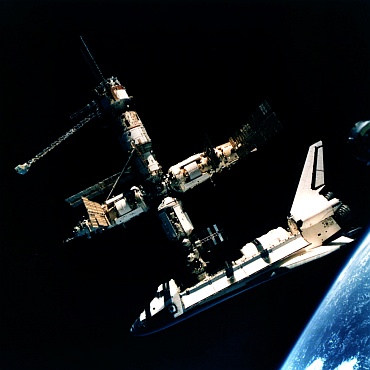
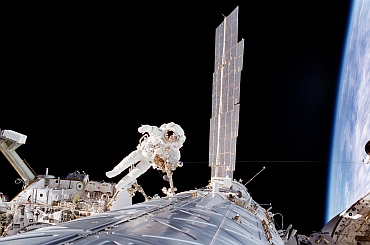
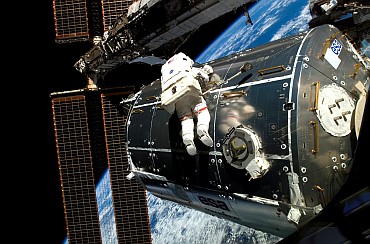
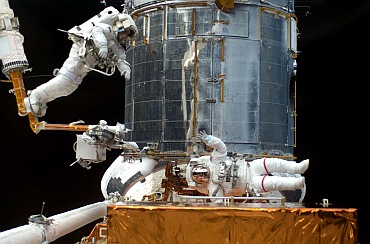
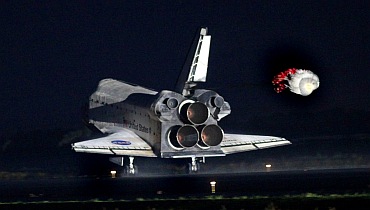
article